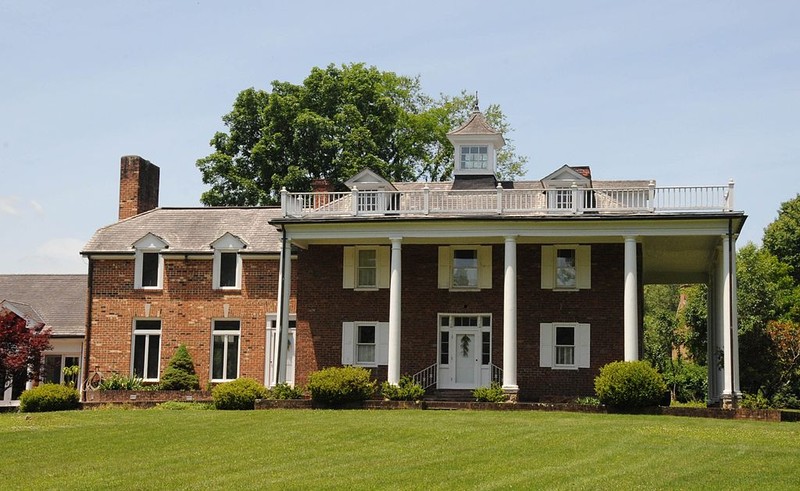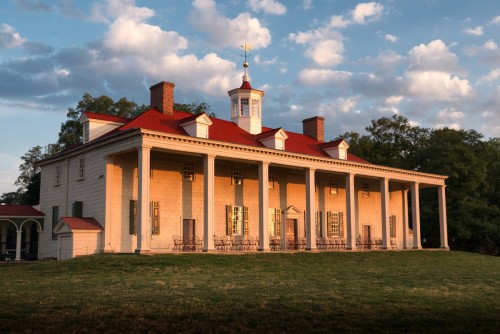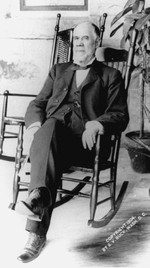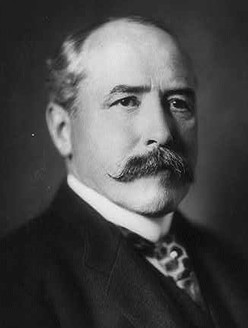Taylor-Condry House
Introduction
Text-to-speech Audio
Images
Modern photo of the Taylor-Condry House.

George Washington's Mount Vernon, upon which the Taylor-Condry House is based.

Henry Gassaway Davis, who Taylor-Condry House resident Blaine Taylor supported for Vice President in 1904.

Alton B. Parker, Henry Gassaway Davis' running mate in the 1904 election.

Backstory and Context
Text-to-speech Audio
Prior to the Civil War, the land that is now Elkins, West Virginia was known as Leading Creek or Leadsville. The plantation of Jacob Ward encompassed much of that area, with Ward’s slave-built home occupying a slight rise overlooking the rest of the property. Ward was no doubt one of the wealthiest individuals in the area given the size of his slaveholdings, large even by the standards of eastern Virginia where slave labor was far more prevalent. Over the course of his life Ward served Randolph County in a number of capacities, including as a justice of the peace and member of the committee responsible for the construction of the area’s first bridge of any substantial size (over the Cheat River). Still, while Ward may have held unchallenged sway as the area’s most prominent figure during the Antebellum Period the coming of the American Civil War brought the winds of change with it. In the 1861 plebiscite held throughout Virginia to decide upon the issue of secession, Randolph County chose to join the eastern half of the state in leaving the Union by a slim majority of nineteen votes. Soon thereafter, however, Federal troops under General George B. McClellan occupied the county, and when McClellan was promoted to command of the Army of the Potomac and left for Washington, D.C. those troops remained. They stayed in Randolph throughout the war, ensuring the county’s inclusion in the new state of West Virginia when it was formed in 1863.
Ward didn’t live in the new state for long, dying in 1866. His heir and son-in-law, Andrew Taylor, ordered the construction of a new home to replace Ward’s former plantation house, built between 1880 and 1881. This new house was one of only two structures in the Leading Creek area along with the “Old White” Church building that housed the local Presbyterian congregation prior to the construction of the Davis Memorial Presbyterian Church in 1895. This makes the Taylor-Condry House one of the oldest structures in the town of Elkins, which was not founded until nearly a decade after the house arose. The building’s appearance certainly reflects that status, designed to mirror that of Mount Vernon, the stately plantation home of the first President of the United States George Washington. Like Washington’s home, Andrew Taylor’s new house features a colonnaded front porch, dormered windows along the roof, and a central cupola. Unlike the Washington plantation, which was built of wood, Taylor’s home used red brick, a building material that was in the eighteenth century considerably more expensive and no doubt less attractive to the notoriously thrifty first president.
Andrew Taylor continued to live in his home for two and a half decades before deeding it to his son Blaine in 1904. Blaine Taylor had already served in a number of prominent positions prior to that time, among them Superintendent of Randolph County Schools, Clerk of both the West Virginia Legislature and State Department, and Chief Clerk of the U.S. Postal Service. In 1904, however, Taylor played a somewhat different role as the Democratic Party’s campaign manager in Randolph County. That year was a particularly notable one for Randolph County, more specifically in terms of its connection to the presidential election. That year, former West Virginia Senator and founder of Elkins Henry Gassaway Davis stood as the Democratic Party’s vice-presidential nominee alongside New York Judge Alton Parker. The party selected Davis as Parker’s running mate in large part because Democratic leaders wished to tap into his vast fortune to defray campaign costs. Unfortunately for the party, Davis’ wealth did not translate into any sort of political advantage. The similarity of the candidate’s campaign positions instead translated into a contest of personalities, which the Republican incumbent Theodore Roosevelt easily won. In fact, Roosevelt’s margin of victory was the largest since James Monroe’s election in 1820. Davis could not even help the Democrats secure his own state (although he did win Randolph County).
Despite the setbacks of the 1904 election, Davis remained a prominent figure both nationally and locally. The same year as the election, in fact, his namesake Davis and Elkins College in the town of Elkins was born, a project to which he contributed heavily over the remainder of his life. For his own part, Davis’ supporter Blaine Taylor retired from politics to a successful law practice in the town. The arrival of the Great Depression in 1929, however, bankrupted Taylor and he chose to sell his family home. The building’s new owner, Dr. R.J. Condry, was an influential physician in town. Condry remained in residence there for nearly fifty years and is responsible for choosing the name Ednalea. Still, regardless of its title, the Taylor-Condry House is a story that tells of one family’s rise and fall from influence in an area of West Virginia that has witnessed profound changes over the course of its history.
Sources
Bosworth, Albert Squire. A History of Randolph County, West Virginia, from Its Earliest Exploration and Settlement to the Present Time. Elkins, WV, 1916.
Maxwell, Hu. The History of Randolph County, West Virginia: from Its Earliest Settlement to the Present, Embracing Records of All the Leading Families, Reminiscences and Traditions ..Morgantown, WV: Acme Publishing Co., 1898.
Pepper, Charles M. The Life and TImes of Henry Gassaway Davis, 1823-1916. Century Company, 1920.
Shoemaker, Fred C. "Alton B. Parker: the images of a gilded age statesman in an era of progressive politics." MA thesis, The Ohio State University, 1983.
Wikipedia
The Mount Vernon Association
The West Virginia Encyclopedia
Wikipedia
